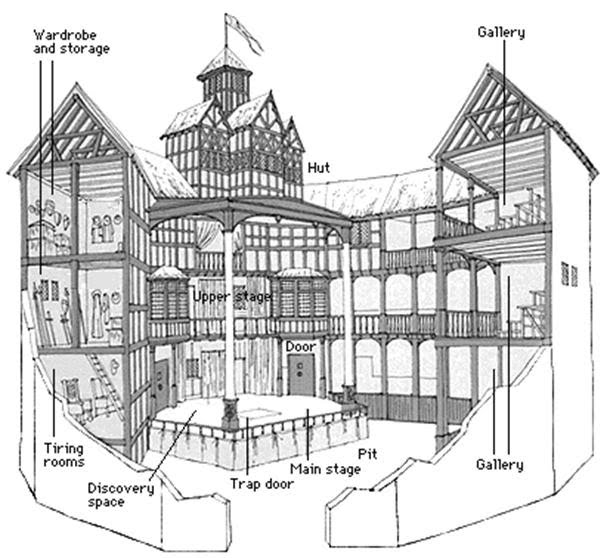Historical
Verona
“There is no world without Verona walls.” Verona is the backdrop of this most famous of tales. One previous Shakespeare play, ‘The Two Gentleman of Verona,’ had been set here, but it was this play which left its mark. Though it is not known for certain whether Romeo and Juliet existed, the Montagues and Capulets (Montecchi and Capuleti) undoubtedly did; both family houses still exist.
The city is now almost synonymous with the idea of love and the tale of two “star-cross’d lovers”, so much so that, every year, thousands of letters are sent to Verona, addressed to Juliet, detailing stories of unrequited love.
The Globe
- It is believed the play was first performed around 1595 by The Chamberlain’s Men, an all-male troupe of actors.
- The theatre would have looked as it does below (and the same as it is now, having been reconstructed after a fire in 1613).
- The Upper Stage would have allowed for the famous balcony scene to take place. Unlike with modern theatre, where large set changes are possible, the stage would have remained essentially the same throughout the duration of the play.
- However, this is the way Shakespeare wanted it. The play depends on the building of pace and tension, so much so, that sometimes scenes are linked together (the last line of Act II Scene I, “…not to be found” and the first line of Act II Scene II “…never felt a wound” are a rhyming couplet).__ __Slow set changes between scenes would have disrupted this.
Comedy
Though Shakespearean Comedies did include humour, a Comedy in those days meant a play which ends with a wedding. Their wedding in the middle of the play and union at the end, certainly hints at this fact (although let’s be honest - it’s definitely a Tragedy!).
But it did have other features of a Comedy:
- They tend to centre on the struggle of young lovers to overcome problems, often due to the interference of their elders. Tick.
- Some element of separation and reunification. Tick, albeit in a tomb…
- There are mistaken identities. Sort of tick, in that Romeo mistakes Juliet for being dead. Awks.
- Family tensions which are resolved by the end of the play. Big tick, like literally the point of the play.
Let’s be clear: ROMEO AND JULIET IS A TRAGEDY. But Shakespeare is playing around with elements of Comedy and it is interesting to spot when and why.
Tragedy
As one of his early Tragedies (only preceded by Titus Andronicus), Shakespeare is undoubtedly playing around with __form: __
It is quite different to the Tragedies of Hamlet, Macbeth and King Lear, which would come later:
- normally the tragic victim is a high-ranking individual but Romeo and Juliet are not;
- the supernatural tends to play a role (ghost in Hamlet, witches in Macbeth) but there is none here;
- the tragic hero tends to have a fatal flaw, but in this it is their families who do.
However, fate is present in Romeo and Juliet. Shakespeare never properly returns to this kind of tragic love story: the plays of Troilus and Cressida and Antony and Cleopatra centre on loveless or one-sided relationships, rather than this truer form of love.
Comi-tragic relationship
As well as a Comedy (with a capital C) it is also important to be aware of the humorous side of the play. Shakespeare uses humour to heighten the drama and tension of the piece:
- The Nurse is the most famous comic character, and provides comic relief at various points.
- The moment when she has to tell Lady Capulet how old her daughter is, is amusing but also hints at a troubled relationship between Lady Capulet and Juliet.
- Similarly, Mercutio at his death makes light of how a fatal wound is only “a scratch.”
- Even Romeo is comical in how quickly his affection changes from Rosaline to Juliet; is it love at first sight or is Romeo just fickle?
Shakespeare
For someone so famous, there is a large amount of mystery surrounding William Shakespeare. This is hardly surprising, given that he was around over four hundred years ago and the man didn’t even spell his name consistently! But we do know some details about him. He married his wife, Anne Hathaway, when he was only 18 (and she was 26). She was already pregnant and they had their first child six months after being married. Though not entirely unusual for the time, it demonstrates that Shakespeare had a fairly early introduction to love and marriage. This might account for his perspective on the play. However, his stance on love might have changed as he got older; after all, in his will, he appears to have only given his wife a bed…
Sources
It is easy to think that Shakespeare concocted all these stories from his imagination, but this couldn’t be further from the truth. Most plays at that time were inspired by sources, and Shakespeare had a number for Romeo and Juliet. Dante’s_ Divine Comedy_ references the Montecchi and Capuleti families, and clearly Shakespeare was aware of the tragic story of Pyramus and Thisbe, as he uses it in A Midsummer Night’s Dream.
But the main source was a poem entitled The Tragicall History of Romeus and Juliet by Arthur Brooke. There are a lot of similarities between the two, essentially retelling the same tale, but more interesting to consider are the differences:
What you should see, in every decision by Shakespeare, is that the characters are put under more pressure and forced to make decisions. Should Juliet defy her parents? Should Romeo avenge his friend? The stakes are much higher as a result.
